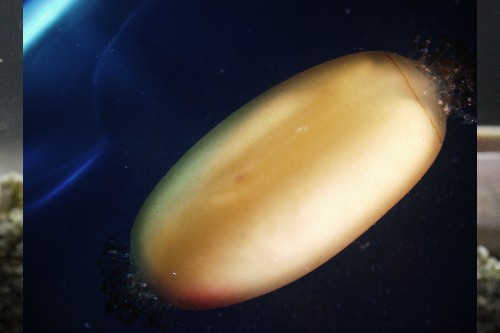
Hagfish Juan Pascual Anaya

Fertilised hagfish egg Juan Pascual Anaya
The first genome of hagfish - the only vertebrate lineage without a reference genome - has been sequenced by an international team of scientists.
The findings, published today in the journal Nature Ecology & Evolution, have helped unravel the evolutionary history of genomic duplications that occurred in the ancestors of vertebrates, including humans. It is now known that the common ancestor of all vertebrates derived from a species that completely duplicated its genome once.
There has been considerable debate among evolutionary researchers as to when these genome duplications occurred in the history of vertebrates, and without information from the hagfish, which separates from the other vertebrates very early in the group's history, it was difficult to place them.
Hagfish, also known as 'sea hags' or 'slime eels,' are deep-sea dwellers. They are recognised for the amount of mucus they release when threatened and their role as an ecological link in the ocean depths—acting as scavengers, responsible for removing, among other things, whale carcasses that end up on the seafloor after death. Until now, their genome had not been sequenced due to its complexity, composed of a large number of microchromosomes, which, in turn, consist of repetitive sequences. Microchromosomes are also lost during the animal's development, which means only the reproductive organs retain a complete genome.
"This study has significant implications in the evolutionary and molecular fields, as it helps us understand the genome changes that accompanied the origin of vertebrates and their most unique structures, such as the complex brain, jaw, and limbs," explained Juan Pascual Anaya, University of Málaga (UMA) scientist and lead author of the study Juan Pascual Anaya.
"This is important because it allows us to compare, for example, the gene order between this and other vertebrates, including sharks and humans. This has resolved one of the most important open debates in genomic evolution: the number of genomic duplications and when these occurred during the origin of different vertebrate lineages."
The lineages that led to modern jawed and jawless vertebrates diverged, and each of these independently multiplied its genome: while the former, including humans, duplicated it, jawless vertebrates tripled the size of their genome. Genome doubling in jawed vertebrates might explain why hagfishes and lampreys are such simple organisms, while jawed vertebrates like sharks and humans are so much more complex.
"Genome duplication in jawed vertebrates was different, resulting from interbreeding between separate species of ancestral vertebrates. This would have disrupted the genome much more severely than genome duplication with species, providing the spur for evolutionary innovations such as vertebrate sensory organs, neural crest cells, a boney skeleton and paired fins, alongside the corresponding increase in regulatory complexity: the number of switches that turn genes on or off" explained Philip Donoghue of the University of Bristol's School of Biological Sciences and corresponding author of the study.
For this research, the genome of Eptatretus burgeri, inhabiting the Pacific coast of East Asia, was sequenced in collaboration with the Chinese Academy of Sciences. Data produced for this study were up to 400 times the size of its genome, using advanced techniques like Hi-C for chromosomal proximity and successfully assembling it at the chromosome level.
An analysis of genome functionality, based on extremely rare hagfish embryo samples from the prestigious laboratory of Professor Shigeru Kuratani at RIKEN; and a study on the potential impact of genomic duplications in each vertebrate, developed in collaboration with Professor Philip Donoghue of the University of Bristol, completes this multidisciplinary research crucial for understanding the evolutionary history of vertebrates.
This nearly decade-long project involved an international consortium with more than 30 institutions from Spain, the United Kingdom, Japan, China, Italy, Norway, and the United States, including the University of Tokyo, the Japan RIKEN research institute, the Chinese Academy of Sciences, and the Center for Genomic Regulation in Barcelona, among others.
Paper:
'Hagfish genome elucidates vertebrate whole-genome duplication events and their evolutionary consequences' in Nature Ecology & Evolution by Juan Pascual Anaya, Philip Donoghue et al.






